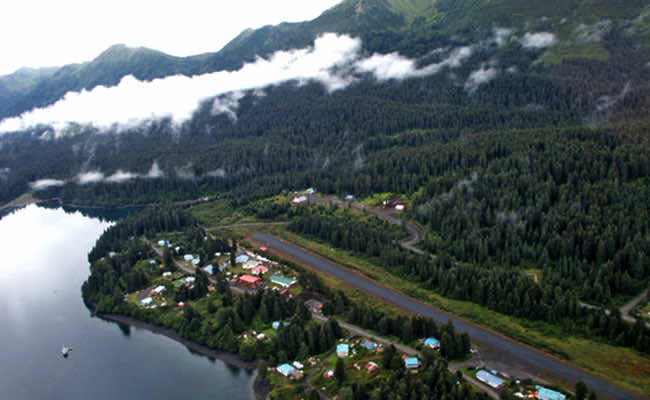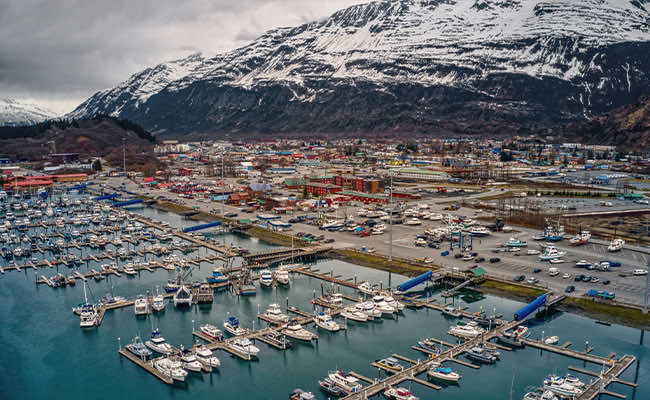OUR REGION
The Chugach Region of Alaska
CRRC Proudly Serves
Seven Tribal Villages
Click on Location for More Information
We, the Chugach Regional Resources Commission, acknowledge the land and waters of our people, the traditional homelands for over 10,000 years, and what we call the Chugach region. The Chugach region includes over 5,000 miles of coastline, over 50 named islands, and over 20,000 square miles of mountains. Today we have over 1,500 Tribal Members living in Chenega, Eyak, Nanwalek, Port Graham, Seward, Tatitlek, and Valdez, including Whittier and our oldest traditional village, Nuchek. These communities are found within the Lower Cook Inlet, Prince William Sound, and Lower Copper River area. Ungualartukut imamek taumi qut’mek – We survived by the ocean and beach. We also acknowledge the space and land CRRC utilizes for our Marine Institute in Seward, the ancestral land of the Qutekcak Native Tribe. This land was and continues to be of great importance to the Alutiiq/Sugpiaq people.
CHENEGA (Caniqaq)

Population: 59
Location: On the eastern shore of Evans Island, in Crab Bay
Tribe: Native Village of Chenega
Fun Fact: CRRC’s Alutiiq Pride Marine Institute and the Chenega IRA Council have been working together on mariculture for over 20 years. Through multiple bivalve enhancement efforts, the community has been able to harvest cockles, steamer clams, and softshell clams in front of the Village to help support subsistence. Chenega became involved in mariculture in 1993 by establishing an oyster farm. The construction of the shellfish hatchery in Seward created the need for nursery systems, and the Village saw the economic potential of becoming involved in this aspect of the industry. In 1996, CRRC wrote a grant on behalf of the Village to construct a floating nursery system, which it anchored close to the village dock to take advantage of the dock’s power supply to run the pump. The Village also built and is testing a floating nursery system that relies on tidal currents to force the plankton-laden seawater through the seed trays.

Village Corporation: Chenega Corporation
Cordova/EYAK (IiyaaGdaad)

Population: 2,187
Location: Nestled between the waters of Eyak Lake and Orca Inlet, Prince William Sound
Tribe: Native Village of Eyak
Fun Fact: Prior to the Exxon Valdez oil spill, Cordova had the largest razor clam population in the state, supported the primary razor clam commercial fishery in the state, and was a major source of subsistence and recreation. In 1996 and 1997, CRRC’s Alutiiq Pride Marine Institute (then the Alutiiq Pride Shellfish Hatchery), funded by the Exxon Valdez Oil Spill Settlement Fund, conducted an enhancement project seeding juvenile razor clams outside of Cordova to provide a baseline for future efforts to restore and enhance razor clam populations. The study took place on the tide flats to support Tribal Members of the Native Village of Eyak. It became apparent during the beach surveys that there are very few razor clams, adult or sub-legal, in the Cordova area. Razor clams were observed throughout the season and the growth and survival were encouraging. Because of limited funding and the high motility of juveniles, it was difficult to determine the ultimate contribution; however, anecdotal evidence suggests the clams had established themselves on a once barren beach. The razor clam study was predicated on the assumption that there were significant numbers of sub-legal razor clams whose survival could be enhanced with predator-control techniques. Since this turned out not to be the case it was decided to cancel further razor clam work.

Village Corporation: Eyak Corporation

NANWALEK

Population: 254
Location: Between English Bay and the lagoon on the southern tip of the Kenai Peninsula
Tribe: Nanwalek IRA Council
Fun Fact: Nanwalek initiated the Nanwalek Salmon Enhancement Working Group, and through this program has collected data on salmon enumeration and escapement of the English Bay Lakes system since the early 1920s in partnership with several fiscal sponsors, such as the CRRC and the Cook Inlet Aquaculture Association. In the early years, the community used spruce trees and root ties for fish weirs. In the early 2000s, a new picket weir was acquired using federal monies. Since 1999, Nanwalek has maintained ownership of their fish weir under their own state operation permit through the Sockeye Salmon Enhancement Project.
Village Corporation: English Bay Corporation
PORT GRAHAM (PALUWIK)

Population:177
Location: On the western shore of Port Graham Bay, on the southern tip of the Kenai Peninsula
Tribe: Port Graham Village Council
Fun Fact: The Native Village of Port Graham constructed a salmon hatchery in 1993. CRRC worked with the Village Council to initiate the hatchery and had been integrally involved in its development since its inception. The hatchery had been supported by many different funding agencies and organizations, although the majority of funding granted directly to CRRC on behalf of the hatchery came from the organization’s Bureau of Indian Affairs P.L. 638 contract. Both red and pink salmon were reared inside the facility while operated by the Village Council. The Port Graham Hatchery was purchased by Cook Inlet Aquaculture Association in 2014 and put back into operation. This is a pink salmon facility with the capacity to rear 84 million eggs based on current water availability. Fish are reared in the facility until they reach the fry stage and then they are temporarily reared in net pens in front of the hatchery. On average the time in the net pens is two months before they are released to the open ocean. The following year, roughly two million adult pink salmon returned.

Village Corporation: Port Graham Corporation
SEWARD (QUTALLEQ)

Population: 2,831
Location: At the head of Resurrection Bay, a fjord of the Gulf of Alaska on the Kenai Peninsula
Fun Fact: In the early 1990s, there was no facility in the state for producing seedstock. This left oyster seed, which could be imported, as the only species available for farming. It soon became apparent that if the industry was to survive, additional shellfish species had to be made available to aquatic farmers. To address this problem the Marathon Native Tribe (MNT), began operating a small pilot facility at the Seward Marine Center in 1994 to test the potential for producing Alaska shellfish seedstock. In 1996 the State of Alaska funded the construction of a first-class Mariculture Technical Center in Seward. The facility was completed in January 1998. MNT then changed its name to the Qutekcak Native Tribe (QNT) and operated the City of Seward’s Mariculture Technical Center from 1998 to 2004 with the help of CRRC. QNT and CRRC developed a business plan for the facility and various techniques and methodologies for production and for improving species culture. In September 2004, QNT made the decision to close the Qutekcak Tribal Shellfish Hatchery. CRRC took over operations later that year and renamed the operations Alutiiq Pride Shellfish Hatchery. CRRC later rebranded the facility to the Alutiiq Pride Marine Institute (APMI) to encompass the vast services provided to the region inside the facility.

TATITLEK (TAATIILAAQ)

Population: 88
Location: On the northeast shore of Tatitlek Narrows, on the mainland in Prince William Sound
Tribe: Tatitlek IRA Council
Fun Fact: CRRC and the Native Village of Tatitlek constructed a Mariculture Building in Tatitlek. It was designed to serve as a nursery and processing facility, allowing the farm to process and hold product in wet storage and enabling it to deliver fresh product even when weather conditions made harvesting difficult. Tatitlek saw the potential of mariculture and with CRRC’s assistance received a farming permit in 1991. At peak production, Tatitlek produced 300,000 oysters a year and tested the potential of littleneck clams.

Village Corporation: The Tatitlek Corporation
VALDEZ

Population: 3,862
Location: At the head of a fjord on the northeast side of Prince William Sound
Tribe: Valdez Native Tribe
Fun Fact: Between 1995 and 2000, with funding from the Exxon Valdez Oil Spill Trustee Council, CRRC spearheaded a project for Alaska Native communities to become more involved in the restoration efforts of the Trustee Council. CRRC contracted with Tribal Councils in the Chugach region, including the Valdez Native Tribe. Between 1998 and 1999, the Tribe received funding from the Trustee Council to conduct a population assessment of spot shrimp in Prince William Sound. This species has traditionally been a strongly used subsistence resource. The Valdez Native Tribe is very concerned about the decline in the population from pre- and post-spill numbers.

Village Corporation: Valdez Native Tribe


